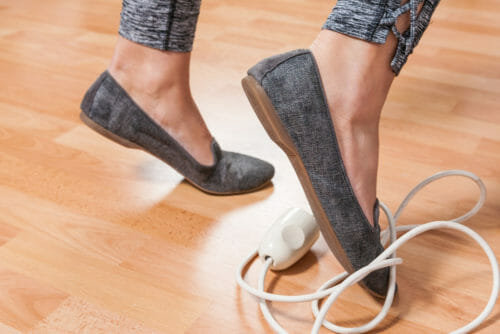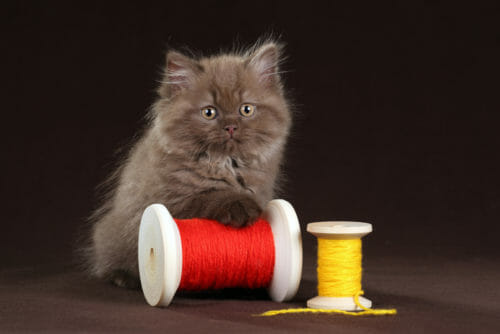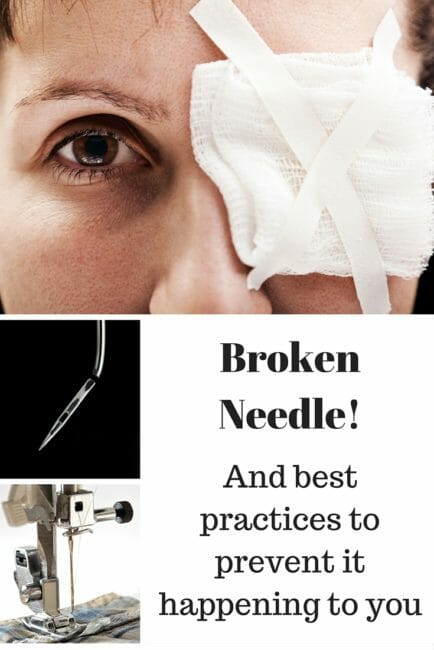
In terms of safety, sewing is certainly a lot safer than skydiving, bullfighting, or even just driving a car. That being said, sewing does still present some genuine dangers so sewing machine safety is critical. Today's sewing machines are run by electricity and have dangerous moving parts like sharp needles; this means there are bound to be some safety concerns. Here are some helpful safety tips to follow in order to stay safe whilst enjoying the hobby we all love so much.
Needles are sharp. Keep fingers away:
Getting your fingers sewn isn’t a fun experience. One way of avoiding this risk is to buy finger guards from the maker of your machine. Such guards will keep your fingers protected from the needle but frankly, most people chose not to wear them. However, since more the 60% of sewing-related injuries which required treatment in hospital resulted from machine needles, it's important to keep your fingers safely away from them.
Avoid distractions:


If you are feeling overly tired it's best you stay away from your sewing machine and, much like operating a car or other machinery, it's best to avoid alcohol as well. You are better off sewing when you're relaxed, clear-headed and under no influence of alcohol or other medications.
Switch off your machine when you're away for more than a minute:
When sewing machines are left to idle, they always generate heat and this can result in them being damaged or destroyed when they remain plugged into electricity. A good safety check for this is to install a surge protector to your machine. Turning off your machine instead of idling also keeps the attention of children and household pets away, who may otherwise be drawn to the humming of an idling machine.
Be cautious of cords:


The best place for cords to be is at the back of the machine and not carelessly dropped on the floor where they can get in the way and possibly lead to an accident. However, should the need to place them on the floor arise for some or other reason, it's always best to secure them down with tapes. Better still, change your location so that it's not necessary. If there are pets at home, it's important to monitor your machine’s cord. If there is any form of damage to the cord, change the cord entirely instead of using tape.
Service your machine at least once every two years:
Regular, professional service ensures that your machine is in top form and that every hidden or potential risk is exposed before it takes you by surprise.
Unplug the power cord before you open your sewing machine:
If you wish to change your light bulb, for instance, it's advisable that you unplug the cord of your machine in order to ensure your safety, as with all electrical appliances, there is always the danger of shock.
Avoid sewing over pins:
If you end up doing this, you make break your needle, your pins will get bent and you will most likely botch your work. For more on the dangers of broken needles, please check out our post: Broken Needle: best practices to prevent it happening to you
Don’t make your machine sew through thick or tough materials:
Doing so can lead to damage to your machine or inflict injury on you. If you must sew through tough materials, you may need an industrial machine.
Take ergonomics into consideration when setting up your sewing table:


A sewing table that is too high will put stress on your back. Plus, when we concentrate we might be inclined to disregard our physical discomfort, leaving us stiff and sore at the end of it. The best sitting position is with your elbows bent at a 90-degree angle and your feet flat on the floor.
Ensure that you wear shoes when sewing:
As odd as this may appear, wearing shoes will protect your feet against a variety of potential dangers including possible electric shock and stepping on one of the many sharp objects associated with sewing, such as pins and scissors. You could also accidentally drop scissors or other heavy objects on your feet. Ouch!
Exercise caution when getting rid of used sewing needles:
The best way of doing this is by putting the needles in a sealable container like a soda can or a prescription bottle. This will stop them from piercing the bag and posing a risk to people (and children) in the future.
There has to be sufficient lighting in your workstation:
This helps reduce the strain on your eyes, high concentration in dim light can lead to headaches, migraines, and damage to your eyes.
If you have pets, like cats, keep thread spools away from them:


The reason for this is that cats love playing with spools and may end up swallowing them, leading to health complications that require expensive operations and cause all kinds of suffering for you and your beloved pet.
With all you've learned so far, ensuring the safety of yourself and your loved ones around your sewing machine shouldn't be a problem at all.
Happy sewing!









I recently made a trip to urgent care for stitches in my thigh when I tried catching it after dropping it. The momentum put it in my thigh and I found it rips tissue as equally well as fabric. Now anything I drop will.hit the floor and then be picked up.
I just bought finger guards for my featherweights! I need to clean one, but that will be used by grandaughter! Safety first with us all!
I don’t think that cats can swallow an entire spool of thread. They can, however, swallow the thread, and that has caused problems for my cats.
Ha! I was just telling my husband about when I sewed across the tip of my left forefinger in 7th grade! Most of damage was to my ego. I had been sewing for over 5 years then and was balking at sewing the simple t-shirt that was the class assignment. I was sewing the neckline facing down and was going too fast and my finger went under the foot and of course instead of stopping, I stomped on the foot pedal and went faster! All the way across the tip of my finger. I was so embarrassed! To this day I can remember the look on our teacher’s face when I told her (it has been only a fast 46 years ago!). I only use a stiletto near the foot now!
When I was younger, I ‘sewed’ my finger. Unfortunately, for all of us, our first inclination is to jerk your finger away, which I did, and ended up with a few stitches. Healed fine with no problems, but, yes, please keep fingers safe! I am more careful now, but have had a few near misses over the years.
I used it for a school project.
Something I’ve had to teach myself over and over!!!!!!!!!!!! “Take your foot OFF the foot pedal when you are not actually using the machine!!” I have had too many near misses with hitting my fingers with the needle holder etc(and possibly being stabbed by the moving needle).My own mother was taken to hospital (one of my earliest memories when I was about 3 years old) when she had put a machine needle right through her finger.
My mother told me that she sewed through her fingers, too. All of them on one hand.
well this is cool
Good Job
I used this for collage work, quite useful.
i think that im pretty cool